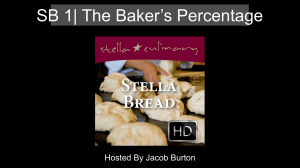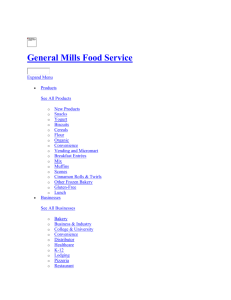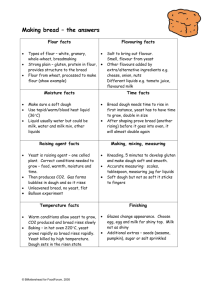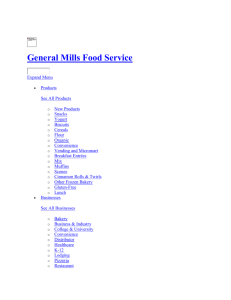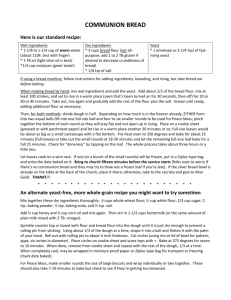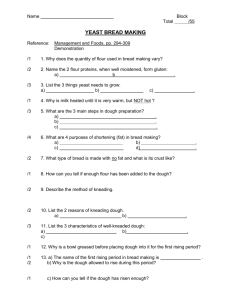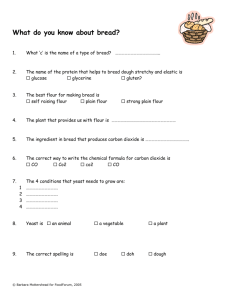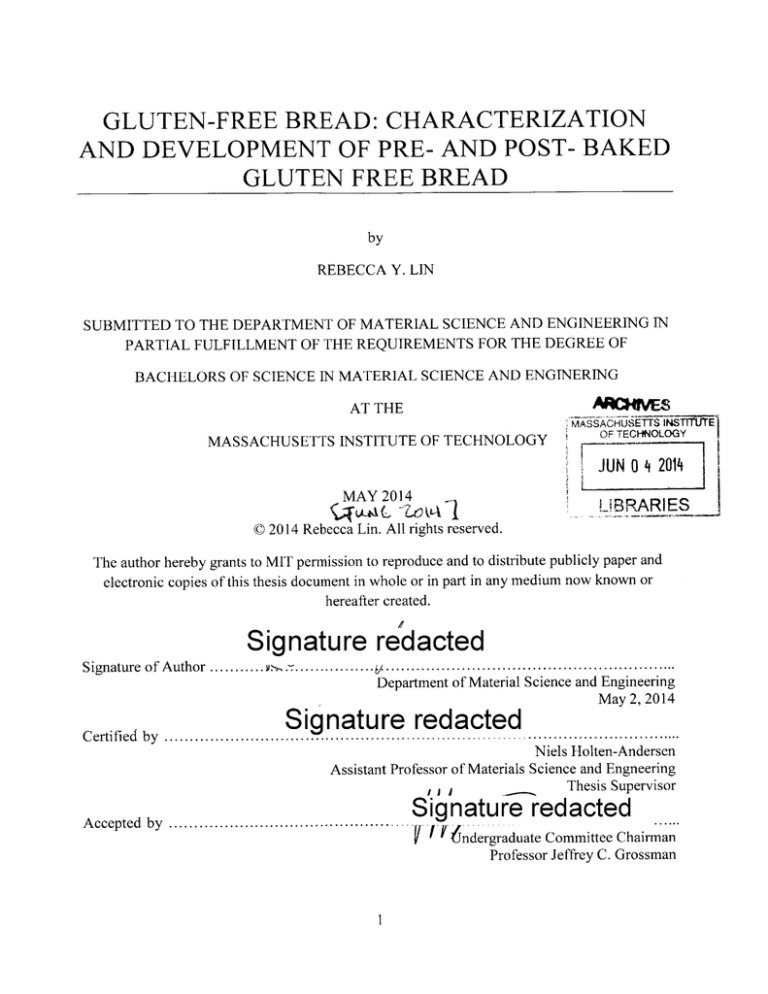
GLUTEN-FREE BREAD: CHARACTERIZATION
AND DEVELOPMENT OF PRE- AND POST- BAKED
GLUTEN FREE BREAD
by
REBECCA Y. LIN
SUBMITTED TO THE DEPARTMENT OF MATERIAL SCIENCE AND ENGINEERING IN
PARTIAL FULFILLMENT OF THE REQUIREMENTS FOR THE DEGREE OF
BACHELORS OF SCIENCE IN MATERIAL SCIENCE AND ENGINERING
AT THE
MSSC
MASSACHUSETTS INSTITUTE OF TECHNOLOGY
ETS INS
OFTECHNOLOG
JUNO0 42014
MAY 2014
( 4 L*C
"
-2mlOkX
0 2014 Rebecca Lin. All rights reserved.
The author hereby grants to MIT permission to reproduce and to distribute publicly paper and
electronic copies of this thesis document in whole or in part in any medium now known or
hereafter created.
Signature redacted
Signature of Author ...........
........................................................
..................
Department of Material Science and Engineering
May 2, 2014
Certified by
Signature redacted
..................... ............. . . .. .. . . .. . . . . . . . .
Niels Holten-Andersen
Assistant Professor of Materials Science and Engneering
Thesis Supervisor
Accepted by
.............................
~
~
~
~~ ~
Accepted
1
redacted
Signature
by~ ..................--V- -
6
ndergraduate Committee Chairman
Professor Jeffrey C. Grossman
TABLE OF CONTENTS
ABSTRACT
6
OBJECTIVES
7
INTRODUCTION
7
Gluten-based Bread vs. Gluten-free Bread
8
Bread Proteins
9
Gluten-free Flours
Quinoa Flour
Sorghum Flour
Brown Rice Flour
10
11
11
11
Starches and Gums
11
Other Functional Ingredients
12
MATERIALS AND METHODS
12
Materials
12
Bread Preparation
12
Basic Bread Formulations
15
Bread Evaluation Techniques
Scanning Electron Microscopy (SEM)
Evaluation of Moisture Content
Rheological properties of the dough
Porosity
16
16
16
17
18
RESULTS
18
Bread Imaging
19
Scanning Electron Microscope Imaging
24
2
Rheological Measurements
26
Moisture Content
32
Porosity
32
CONCLUSION
34
ACKNOWLEDGEMENTS
34
REFERENCES
35
3
TABLE OF FIGURES
Figure 1: Traditional gluten-based bread ingredients and proof time descriptions .....................
8
Figure 2: Gluten-free bread ingredients and proof time. Purple color indicates differences from
traditional gluten-based bread form ulations ................................................................................
9
Figure 3: Gluten-free baking m ethodology...............................................................................
14
Figure 4: Gluten-free bread formulations (post-baking).............................................................
19
Figure 5: : Xanthan gum samples represented by samples 11-13 in Table 4 (a) 0% xanthan (b)
0.3% xanthan (c) 0.6% xanthan .................................................................................................
20
Figure 6: Cross-sectional view of commercial and gluten-based bread. Gluten-free bread mix
made according to Bob's Red Mill (left), Sandwich Bread Recipe according to King Arthur
F lour (right)...................................................................................................................................
20
Figure 7: Cross-sectional view of gluten-free bread samples...................................................
22
Figure 8: Post-baked loaves for loaves at varying xanthan concentrations (Left to right: 0%
xanthan (sample 13), 0.3% xanthan (sample 11), 0.6% xanthan (sample 12)..........................
23
Figure 9: SEM images for Brown Rice Flour and Quinoa Flour (Sample 2) baked bread at
varying magnifications (top left X30; top right X550; bottom left X1,000; bottom right X2,500)
.......................................................................................................................................................
24
Figure 10: SEM pictures of different bread loaves (a) gluten-based bread (b) commercial glutenfree bread mix (c) BRF, QF, and xanthan gum (d) BRF and QF ..............................................
25
Figure 11: Storage and Loss Modulus graph for Sample 1 (BRF, SF), Sample 2 (BRF, QF), and
S am ple 3 (Q F , S F ) ........................................................................................................................
26
Figure 12: Dough loss factor for all brown rice and quinoa flour samples compared to regular
bread and gluten-free bread m ix ................................................................................................
27
Figure 13: Dough loss factor for gluten-free bread samples with varying xanthan gum
concentrations (0%, 0.3%, and 0.6%). Commercial gluten-free bread dough and gluten-based
dough graphs are included for reference...................................................................................
28
4
Figure 14: G', G", and complex viscosity graph for gluten-free vs. gluten-based bread. Glutenfree data is based off of Sample 8 (BRF, SF, QF, xanthan gum, and potato starch)................ 29
Figure 15: G' for samples (11-13) at varying concentrations of 0%, 0.3%, and 0.6% xanthan gum
.......................................................................................................................................................
30
Figure 16: Dough Viscosity for xanthan samples and 0.5% corn starch sample.......................
31
Figure 17: Volumetric weight loss for gluten-free bread (samples 1-9) and gluten-based bread
(sample 10), and xanthan samples (samples 11-13) .................................................................
32
Figure 18: Image of 0.3% Xanthan Gum baked sample after ImageJ Analyze Particle analysis;
black (pores), w hite (bread).....................................................................................................
33
Figure 19: Average pore size of samples 11-13 with varying amounts of gluten (0, 0.3%, and
0.6% ). Data was gathered using ImageJ analysis .....................................................................
34
TABLE OF TABLES
Table 1: Protein content of various gluten-based and gluten-free flours based on mass
percentages from Bob's Red M ills......................................................................10
Table 2: Gluten-free bread formulation including brown rice, quinoa, and sorghum flour.......15
Table 3: Gluten-based sandwich bread formulation from King Arthur Flour...........................16
Table 4: Formulations by volume percentages for flour, starches, and gums....................18
5
GLUTEN-FREE BREAD: CHARACTERIZATION AND
DEVELOPMENT OF PRE- AND POST- BAKED
GLUTEN FREE BREAD
By
REBECCA Y. LIN
Submitted to the Department of Material Science and Engineering on May 2, 2014
in Partial Fulfillment of the Requirements for the Degree of Bachelor of Science in
Material Science and Engineering
Abstract
The study was conducted to characterize the effects of xanthan gum on gluten-free bread
formulations. An improved gluten-free flour blend consisting of brown rice flour, quinoa flour,
and sorghum flour was used with the aim of developing a gluten-free bread formulation
comparable to traditional gluten-based bread and commercial gluten-free bread mix. Rheological
measurements were taken to analyze the effects of xanthan gum on pre-baked dough
formulations. Higher concentrations of xanthan gum were found to decrease the loss factor thus
strengthening the elastic properties of the dough, elongating the linear viscoelastic region and
increasing the viscosity of the dough. Furthermore, the xanthan gum samples were not
independent of frequency and the loss factor decreased as frequency increased. Porosity of
samples was also analyzed using imaging technology to determine the average pore size. Pore
size increased as xanthan gum concentration increased indicating the ability for xanthan gum to
retain gas during the proofing stage before baking. It was concluded that xanthan gum was
necessary for a loaf with nice crumb texture, loaf color, and moisture content though different
than gluten-based and commercial brand gluten-free bread mix. 0.3% xanthan gum concentration
provided the most desirable post-baked crumb texture, loaf volume, and moisture content
Thesis Supervisor: Niels Holten-Andersen
Title: Assistant Professor of Material Science and Engineering
6
Objectives
The objective of this study was to understand the effect of xanthum gum on a new glutenfree bread formulation. A special gluten-free flour blend and formulation was developed and
compared to both gluten-based bread and a standard commercial gluten-free bread mix. In order
to do so, bread was characterized for its moisture content, average pore size, and rheological
behavior of dough. In addition, a secondary objective emphasized the use of creating a
formulation with less than 15 common ingredients found at local grocery stores due to the high
cost of a gluten-free diet. A previous formulation (Boswell 2010) was used as a baseline and was
adapted and modified to according to the objectives and other research formulations. Preliminary
baking trials were conducted using potato starch, sorghum flour, and brown rice flour, and were
later expanded to include quinoa flour and xanthan gum.
Introduction
Bread, a staple food product, is a popular item made and eaten all over the world. Various
types of bread-like substances exist and bread has evolved rapidly over the years to achieve
creative products for the hungry consumer. The unique chemistry of bread is derived from the
properties of the gluten network that is formed during the dough making process. Gluten's ability
to form, deform stretch, and trap gas gives bread its unique porous structure, texture, and dough
properties (Cauvain 2007).
In the past decade, gluten-free products have rapidly gained popularity in the United
States. Celiac disease, a genetic autoimmune disorder, affects 1 in 100 people rendering them
unable to properly digest the gluten protein. In those with gluten sensitivities, ingestion of gluten
will damage the small-intestinal mucous lining caused by the gliadin, a bread protein used to
form gluten, and other similar alcohol-soluble proteins.
Gluten-free bread has been criticized for some of its undesirable characteristics. Recent
studies have shown that gluten-free bread has reduced loaf volume, grainy texture, low moisture
content, and lighter loaf color (Gallagher et. al. 2004). However over the past five years, many
new developments for gluten-free bread have risen in the community. Brands such as Udi's,
Kinnikinnik, Ener-G have released whole-sale versions of gluten-free sandwich breads, but
further research efforts for an affordable home recipe is still under development. Furthermore,
many gluten-free recipes call for complex ingredients such as malodextrin (Witczak et.al. 2010),
hydroxypropyl methylcellulose (HPMC) (Crockett 2011), and transglutaminase (Moore et. al
2006) that are known to improve bread quality but are not easily accessible to the home baker.
Enzymes such as alpha-amylase and xylanases have also been reported to create improved
gluten-free bread recipes (Guarda et. Al 2003) but cannot be found in local grocery stores. Thus,
a need for an affordable gluten-free bread recipe has been identified.
7
Gluten-based Bread vs. Gluten-free Bread
Figure 1: Traditional gluten-based bread ingredients and proof time descriptions
Bread is characterized by its formation of gluten and typically consists of a couple of
major ingredients outlined in Figure 1. The liquids, water and milk, are combined with yeast to
activate the yeast and begin fermentation. Flour is then added to the yeast mixture along with
sweeteners and salt and allowed to combine. Finally, the eggs and fats such as butter, oil, or
shortening are introduced into the dough and it is kneaded until the dough comes together and
the gluten structure begins to form. Once combined, the dough is kneaded for 5 minutes with a
dough hook, and set to proof for 1-2 hours until doubled in size. For a sandwich loaf, the bread is
then shaped into a long roll, placed in a bread pan, and set to rise for another hour until doubled
in size again (Classic Sandwich Bread). The bread is baked at 350'F until golden brown.
8
On the other hand, gluten-free bread consists roughly the same major ingredients of
gluten-based bread, but uses gluten-free flours (amaranth, quinoa, brown rice, etc.) and
introduces the use of starches and gums to compensate for the lack of the gluten network.
Differences in the traditional bread and gluten free bread process are highlighted in purple in
Figure 2. Full details on gluten-free bread making process can be seen in Figure 3, but it can be
noted that gluten-free bread requires only one proofing time that is significantly shorter than
proofing for gluten-based bread.
Figure 2: Gluten-free bread ingredients and proof time. Purple color indicates differences
from traditional gluten-based bread formulations
Bread Proteins
A unique property of wheat proteins is the ability to, once hydrated, form a sticky and
rubbery mass known as gluten. Gluten is derived from 4 major wheat proteins: albumins,
globulins, gliadins, and glutenins each of which contribute uniquely to the protein network in the
dough. Gliadin provides the dough with its adhesive properties and can be very sticky when
9
hydrated. On the other hand, glutenin provides elasticity and strength due to its large complex
protein structure (Cauvain 2012).
During the kneading and mixing process of the dough, gliadins and glutenins absorb
water in the dough and are capable of combining with lipids to form lipoproteins. The gluten
proteins together form a strong network through disulfide and hydrogen bonding along with
hydrophobic interactions which provides the backbone for dough structure (Cauvain 2007).
Gluten's ability to trap gas, deform, stretch, and recover gives dough its unique properties and
structure. The gluten network is responsible for the dough's ability to absorb double its weight in
water ensuring the final product is moist and tender rather than dry and flaky (Gluten).
Furthermore, gluten is responsible for the dough's elastic characteristics and also shapes the
color and crumb texture of the baked bread. Because gluten does not exist in gluten-free bread,
the protein structure usually provided by gluten must be substituted by other ingredients such as
other grain flows, starches, and gums.
Gluten-free Flours
Many different flours have been used in the formation of gluten-free bread each
consisting of their own unique properties and protein content. Typical flours such as all-purpose
or white flour and wheat flour contain approximately 10-14% protein content whereas rice-flour
only contains 6-8% protein content. Thus, even though white rice flour is popular for gluten-free
baking due its white color, neutral taste and easy digestibility, many studies have begun to
employ the use of more unique flours to increase the protein content in the dough. Sorghum flour
(Schober et. Al 2005), quinoa flour (Gallagher and Arendt 2004), soybean flour (Ribotta 2004),
etc. have been added to gluten-free bread formulations in order to provide structure and elasticity
to the batter. The percentage of protein content based on mass percentage for different flours is
displayed in Table 1.
Flour Type
Gluten Flour
All Purpose Flour
Wheat Flour
Barley Flour
Protein Content
11-13%
12-14%
10%
Gluten-Free Flours
6%
White Rice Flour
8%
Brown Rice Flour
14%
Quinoa Flour
12%
Sorghum Flour
and gluten-free flours based on mass
gluten-based
various
of
Table 1: Protein content
percentages from Bob's Red Mills
10
Quinoa Flour
Given the higher protein content and recent popularity in food trends, there was a strong
interest in incorporating quinoa in its flour form into a gluten-free bread formulation. In addition,
quinoa is allergy sensitive and can be easily used in vegan and paleo diets. However, quinoa
flour also has a very distinct, grainy taste and because of its high protein content has a tendency
to make products crumbly and dense. In addition, quinoa flour produces loaves with significantly
higher volume in comparison to gluten-free rice bread (Alvarez-jubete et. Al 2010). Furthermore,
quinoa flour is mostly composed of globulins and albumins rather than gliadins, glutenins, or
prolamin. Globulins and albumins contain less glutamic acid, and also have a more balanced
blend of essential amino acids.
Sorghum Flour
Sorghum flour has become a favorite amongst the gluten-free bread community and is a
staple ingredient all around the world in other countries such as Africa, India, and China
(Rooney and Waniska 2000). Sweet sorghum flour purchased in this experiment is a newer
hybrid of the original white plant that has a sweeter, yet bland flavor. Furthermore, different
sorghum hybrids contain various levels of antioxidants, and can all lend to unique tastes in and
quality of the final bread product. Research combining sorghum flour with various starches to
make gluten-free dough has been examined (Schober, et al 2005), but not many have been
conducted in combination with other types of gluten-free flour. In all gluten-free bread
formulations, especially those containing sorghum, higher water content is needed to create a
batter-like system rather than wheat-based elastic dough flour (Taylor et al 2006).
Brown Rice Flour
Rice flour has been the most popular gluten-free flour substitute due to its hypoallergenic
properties, neutral taste, and abundance (Kadan et. Al 2001). However, rice flour is typically
blended with other flours because it has low amounts of protein and therefore does not contribute
to the elastic-plastic properties found in gluten-based dough (Toufeili et. Al 1994). Many
commercial all-purpose gluten-free flours like King Arthur Flour (Gluten-free Multi-Purpose
Flour)., Cup 4 Cup (Product Info), use white rice and brown rice flour as their baseline
ingredients for all-purpose flour substitutions displaying its wide diversity of usage.
Starches and Gums
Starches
Aside from the functional flours, starches and gums also play a very important role in
gluten-free bread formulation and are the main difference between gluten-based bread and
gluten-free bread (Figure 1). Starches can be used to lighten the flour blend, achieve higher
volume, and provide a more airy texture to dense breads. However, too much starch may also
lead to faster staling (Moore 2004). Cassava starch (Crockett 2011), corn starch (Sanchez et al
2002.), tapioca starch (Ahlborn et al. 2005), and potato starch (Gallagher et al. 2004) are among
the most popular starches used in gluten-free baking. As part of the objective was to limit
11
ingredients to those that were accessible in most local grocery stores, potato and corn starch
identified as most accessible and thus were focused upon in this experiment.
Gums
Without a gluten-free network, gluten-free dough formulations need additional
ingredients to improve the batter's viscoelastic. Gums (hydrocolloids) have been found to
increase viscoelastic properties of dough and are generally used as thickeners and emulsifying
agens. Xanthan, guar, and agar gum are among the most popular hydrocolloids that have been
tested in gluten-free batters to improve the viscoelastic properties, increase gas retention, and
develop post-baked texture. Furthermore, xanthan gum has been found to have a strong effect on
dough viscoelasticity yielding stronger dough (Lazaridou 2007).
Other Functional Ingredients
As seen in Figure 1, aside from flour and water, many other ingredients play a key role in
the formation of bread. Yeast provides the fermentation process and the proofing effect in dough,
where salt (sodium chloride) regulates yeast fermentation and monitors for a steady rate of dough
expansion. Liquids hydrate the yeast molecules and are used to blend all of the ingredients
together. Sweeteners act as food for the yeast, contribute to the overall flavor, and lead to a
golden brown crust color. Fats are also used to retain CO 2 gas in dough, improve taste, and
increase volume and texture. Fats give dough its post-baked qualities such as tenderness,
richness, and moisture whereas eggs also contribute to dough tenderness and richness, and
provide color to the finale bread product (Common Baking Ingredients).
Materials and Methods
Materials
Gluten-free quinoa flour, brown rice flour, and sorghum flour were purchased from Bob's
Red Mill (Milwaukee, OR). Organic cane sugar was purchased from Trader Joe's (Morovia, CA),
corn starch was obtained from Sigma Aldrich (St. Louis, MO). Active Dry Yeast, potato starch,
and xanthan gum were also purchased from Bob's Red Mills (Milwaukee, OR). Wesson's
vegetable Oil (ConAgra Foods, Omaha, NE), Morton Salt (Chicago, IL), eggs, and milk were all
purchased from a local grocery store.
Bread Preparation
Batter was prepared according to the methodology shown in Figure 2. Dry ingredients
(flours, starches, gums, sugar, and salt) were whisked together to incorporate all of the dry
ingredients together before added to the yeast mixture. In addition, all ingredients were brought
to room temperature before being used to make dough. Ingredients were combined in an Artisan
Kitchen Aid Mixer (St. Joseph, Michigan). 650g of batter was poured into a PAM sprayed and
parchment paper lined 1 pound Chicago's Metallic's bread pan (Chicago, IL). The remaining
approximately 20g of the batter was used in testing on the rheometer, but was left to proof for at
12
least 30 minutes before doing so. Proofing time varied around 30-45 minutes as proofing was
based up on the doubling of batter rather than by time to achieve more accurate representation of
the bread, typically up to the top of the baking pan. Baking occurred in a Maytag Performa oven
(Benton Harbor, MI) at 350F. After baking, the bread was allowed to sit for at least 15 minutes
before removed and transferred to a cooling rack to cool thoroughly. Breads were later double
wrapped tightly in plastic wrap and stored frozen until analysis.
13
Nil
I~
NI
NI
NJ/
4,
Figure 3: Gluten-free baking methodology
14
Basic Bread Formulations
Sample 11- Gluten Free Bread Formulation
Total
Percentage
Ingredient
Brown Rice Flour
20.42%
Quinoa Flour
10.05%
Sorghum Flour
6.61%
Sugar
2.09%
Salt
0.61%
6.61%
Potato Starch
0.31%
Xanthum Gum
Water
27.75%
Egg
7.85%
3.46%
Canola
0.63%
Yeast
Milk
13.61%
100.00%
Total
Weight as
Prepared (g)
136.5
67.2
44.17
14
4.06
44.17
2.1
185.5
52.5
23.1
4.2
91
668.5
Table 2: Gluten-free bread formulation including brown rice, quinoa, and sorghum flour
The commercial based bread mix was purchased from Bob's Red Mill and was prepared
according to the directions on the package. The exact percentage of the ingredients was not
discovered, but the ingredients of the package in descending proportions is as follows: garbanzo
bean flour, potato starch, corn starch, white sorghum flour, cane sugar, faca bean flour, xanthan
gum, yeast, potato flour, sea salt, guar gum, soy lecithin, milk, egg, oil, and cider vinegar (GF
Homemade Wonderful Bread).
The gluten-based sandwich bread formulation was taken from King Arthur Flour
recommendation in the following proportions.
15
Ingredient
Flour
Water
Milk
Oil
Sugar
Yeast
Salt
Total
Gluten-based Bread Formulation
Total
Percentage
52.63%
18.55%
15.79%
6.32%
3.29%
2.76%
0.66%
100.00%
Weight as
Prepared (g)
400
141
120
48
25
21
5
760
Table 3: Gluten-based sandwich bread formulation from King Arthur Flour
Bread Evaluation Techniques
Scanning Electron Microscopy (SEM)
The structure of the samples was analyzed using a JEOM JSM 661 OLV scanning electron
microscope. Baked samples were attached onto an aluminum specimen stub using double-sided
carbon tape and examined under high vacuum in a scanning electron microscope. Secondary
electron images were acquired at an accelerating voltage of 15kV.
Evaluation of Moisture Content
Once bread was fully cooled, at least two hours after baking, loaves were double wrapped
in plastic wrap, labeled, and stored in a freezer until further tests could be conducted. For
moisture analysis tests, loaves were removed from freezer and allowed to thaw at room
temperature for at least three hours prior to testing.
1 cm thick slices of bread were cut from the middle half of each loaf. Then, each slice
was further divided at a height of 3 cm to obtain a 3cm x 9cm x 1cm rectangle of bread. After
bread was cut, weight in grams of each rectangle was measured and recorded. Samples were then
baked at 350'F for 15 minutes before removing, cooling, and re-measuring. Percent weight loss
was calculated and used to analyze moisture content by assuming that mass loss was equal to
moisture lost during baking process.
Furthermore, by baking the bread for a second time, not only was the moisture content
evaluated, the bread's ability to brown and toast was discovered. As gluten-free bread has been
highly criticized for its dense and gummy structure and light color, the ability for the bread to
toast was an important parameter that could be used to compare the formulation to its glutenbased counterpart.
16
Rheological properties of the dough
The dough samples were prepared via method shown in Figure 3, and a small portion was
removed after proofing for rheological testing. Rheologica data was collected at a constant
temperature of 25'C, using an Anton Paar Modular Compact Rheometer MCR 302. All samples
were conducted using measuring plate PP25 which had a diameter of 25mm. The following test
protocol was adhered to:
1)
Frequency Sweep
The complex viscosity, storage modulus (G') and loss modulus (G") were measured at a
constant strain of 1% with varying angular frequency from 100 to 0.1 rad/s with a ramp
logarithmic profile.
2) Flow Curve
Viscosity of the sample was measured when shear rate was varied logarithmically from
0.001 - 100 1/s.
3) Sample was held for 10 minutes at 25'C.
4) Strain Sweep
At a constant angular frequency of 10 rad/s, the range of viscoelasticity was measured
based on the storage modulus (G') and the loss modulus (G") at a varying strain from 0.1
to 100%.
These dynamic mechanical test methods collect a more accurate representation than prior
test methods such as a farinograph, extensograph, or Intsron as these test methods only determine
single point measurements and cannot provide detailed visco-eleastic properties of the sample
(Crockett 2011). Thus, using a frequency sweep and strain sweep test allowed for the many
variables such as elastic and loss modulus, loss factor, and viscosity to be detected. Experimental
data was described by the following equations.
G' = -cos 6
E
a
G" = - sin S
E
tanS =
G"f
Where G' - storage modulus [Pa], G" - loss modulus [Pa], a - stress, E- strain, and 5- phase
shift. G' displays the dough's ability to store energy whereas G" measures the dough's ability to
dissipate energy in the form of heat. In the case of bread, the elastic properties affect crust
formation and gas retention while the liquid/viscous properties are largely affected by water and
gas retention as well as gas expansion (Crockett 2011).
17
Porosity
Porosity of samples was determined using image analysis. A quarter way through the loaf,
a cross sectional picture was taken. The picture was converted to a binary form, and image
analysis was performed using ImageJ to calculate average pore size and percent area of pores.
Images were cropped in order to ensure that only bread was analyzed, and no background was
taken into account.
Results
Volume percentages for all gluten-free bread formulations are detailed in Table 4 below.
Sample 9 is excluded as it represents the commercial gluten-free bread mix.
Ingredients
Sample 1
Brown Rice Flour
Sorghum Flour
Potato Starch
Sample 2
Sample 3
Sample 4
Sample 5
Brown Rice Flour
Quinoa Flour
Weight
Percentage
Brown Rice Flour
20.28
Quinoa Flour
Sorghum Flour
10.47
20.75
Potato Starch
0.52
20.75
Xanthan Gum
0.21
Sample 8
0.62
0.62
Quinoa Flour
Sorghum Flour
20.75
20.75
Potato Starch
0.62
Brown Rice Flour
13.76
Quinoa Flour
Sorghum Flour
13.76
13.76
Potato Starch
0.62
Sample 10
GlutenBased
Bread
Sample 11
20.42
9.95
Flour
Water
52.63
18.55
Milk
Oil
Sugar
Brown Rice Flour
15.79
6.32
Quinoa Flour
Sorghum Flour
10.05
6.61
3.29
20.42
6.61
Brown Rice Flour
20.42
Potato Starch
Quinoa Flour
Potato Starch
20.42
0.77
Xanthan Gum
Brown Rice Flour
20.42
0.77
Quinoa Flour
Sorghum Flour
10.05
Sample 12
0.31
Brown Rice Flour
20.42
Quinoa Flour
Potato Starch
20.42
Potato Starch
6.61
0.52
Xanthan Gum
0.63
0.52
Brown Rice Flour
20.42
Quinoa Flour
Sorghum Flour
10.05
Potato Starch
6.61
Xanthan Gum
0.00
Corn Starch
Brown Rice Flour
Sample 7
Ingredients
20.28
Potato Starch
Corn Starch
Sample 6
Weight
Percentage
20.42
Quinoa Flour
Potato Starch
20.42
0.53
Xanthan Gum
0.73
Sample 13
Table 4: Formulations by volume percentages for flour, starches, and gums
18
6.61
6.61
Bread Imaging
Figure 4: Gluten-free bread formulations (post-baking)
(a) SF only (b) BRF, SF (c) BRF, QF (d) QF, SF (e) BRF, QF, SF (f) BRF, QF, corn starch
(g) BRF, QF, corn starch (dec.) (h) BRF, QF, xanthan (i) BRF, QF, SF xanthan (dec.) (j)
Commercial GF bread mix (k) Regular Bread
The sorghum only formulation was modified off of Boswell's laboratory gluten-free
yeast formulation however was modified to fit the objectives of this paper. Therefore, non-fat dry
milk powder was substituted with milk in an appropriate liquid proportions and expandex, a
modified tapioca starch, was removed. Next, varying proportions of brown rice flour and quinoa
flour were added until a desirable bread quality, loaf volume, and loaf color were achieved (see
Table 4 for more details). In Figure 4, as samples progress from a-i, loaf color darkens to a more
golden brown and loaves are less susceptible to fallen center seen in sample g.
In Figure 4, the center of some of the breads fell dramatically when exposed to the hot
oven temperature or when removed from the hot oven temperature. As this happened in various
formulations with all different flours, starches, and gums, the falling center was not due to any
specific type of flour. The fallen center was due to a low ratio of solid to liquid in the
formulation. Thus, by adding xanthan gum in samples h-j, which increased the solid properties of
the dough, the fallen center was not present post-baking.
19
Figure 5: : Xanthan gum samples represented by samples 11-13 in Table 4 (a) 0% xanthan
(b) 0.3% xanthan (c) 0.6% xanthan
Figure 5 displays the affects that varying xanthan gum concentration had on the loaves.
With no xanthan gum, sample A was not able to properly retain the gas released during proofing
and did not rise as much as expected. In addition, the bread cracked which could be due to the
dough being insufficiently mixed. As xanthan gum is an emulsifying agent, without xanthan gum,
the particles in the batter are more susceptible to separation during the proofing process and may
not have been thoroughly distributed.
Figure 6: Cross-sectional view of commercial and gluten-based bread. Gluten-free bread
mix made according to Bob's Red Mill (left), Sandwich Bread Recipe according to King
Arthur Flour (right)
Figure 6 highlights the two controls used as a baseline for this experiment. The
commercial gluten-free bread contained a much higher ratio of eggs than any other formulation
20
and this resulted in a bread loaf similar to brioche (egg-based gluten bread). The commercial
grade bread proofed quickly and had a higher loaf height than experimental formulations.
However, post-baking, the bread volume decreased rapidly once out of the oven and a unique
mushroom -like structure was made once the bread was removed from the pan (Figure 6-left).
The gluten-based sandwich bread seen on the right hand side of Figure 6 had the highest
loaf volume of all of the formulations. The gluten network allowed for rapid gas retention and
gas expansion thus resulting in a tall loaf that maintained in shape once removed from the oven.
The resulting texture was also more airy and cohesive in comparison to the more dense and egglike texture of the commercial gluten-free bread mix.
21
Figure 7: Cross-sectional view of gluten-free bread samples.
(a) SF only (b) BRF, SF (c) BRF, QF (d) QF, SF (e) BRF, QF, SF (f) BRF, QF, corn starch
(g) BRF, QF, corn starch (dec.) (h) BRF, QF, xanthan (i) BRF, QF, SF xanthan (dec.) (j)
BRF, QF, SF, xanthan 0.3% (k) BRF, QF, SF, xanthan 0.6% (1) BRF, QF, SF, xanthan 0%
The sorghum flour only bread (a) produced very dry and crumbly bread. However, when
combined in equal ratio with brown rice flour or quinoa flour, the bread produced a much more
desirable texture, crumb quality, and taste. Due to sorghum and quinoa's distinct flavor a higher
ratio of brown rice flour was used as a baseline and then blended with equal percent of both
22
sorghum flour and quinoa flour to even the protein content and density of the bread. This
combination of flours produced a much more desirable taste and crumb texture.
Sorghum flour alone also prevented a browning of the bread. In Figure 7, the bread made
with sorghum flour (a) as well as formulations using greater than 20% sorghum flour (b and d)
tended to be lighter color beige color in comparison to the other breads. However, in
formulations where SF was between ~10-15% (samples e and i), the bread exhibited a slight
browning effect.
Addition of xanthan gum also played a significant role on springiness and gumminess of
bread. When xanthan gum concentrations were greater than 0.6%, the resulting bread had an
unnatural springiness and texture was gummy. When the sample was torn, the sample stretched
rather than crumbled further perpetuating the gummy property. However, without xanthan gum,
the bread did not rise properly resulting in a short, dense loaf shown in Figure 8 below.
Figure 8: Post-baked loaves for loaves at varying xanthan concentrations (Left to right: 0%
xanthan (sample 13), 0.3% xanthan (sample 11), 0.6% xanthan (sample 12)
The post baked loaves show significant differences in loaf volume given the same mass
of dough in the pan. The 0.3% xanthan sample had the highest loaf volume followed closely by
the 0.6% xanthan gum sample. The 0% xanthan gum sample had difficulty in the initial rising
and did not rise to the top of the loaf pan even after double the allotted proofing time given
23
Scanning Electron Microscope Imaging
Figure 9: SEM images for Brown Rice Flour and Quinoa Flour (Sample 2) baked bread at
varying magnifications (top left X30; top right X550; bottom left X1,000; bottom right
X2,500)
The SEM images in Figure 9 depict the air pockets that form within the dough during the
baking process. The image shown in the bottom right image at x2500 magnification show pores
from 2-8ptm in diameter integrated all throughout the bread.
24
Figure 10: SEM pictures of different bread loaves (a) gluten-based bread (b) commercial
gluten-free bread mix (c) BRF, QF, and xanthan gum (d) BRF and QF
From the SEM images shown in Figure 10, the density differences in samples can be
identified. Sample A and Sample C contain larger distinct air pockets while Samples B and D are
dense and more compact. Furthermore, since Sample B is comprised mostly of garbanzo bean
flour, it can be observed that the resulting bread is more fibrous and contains longer strands in
comparison to samples C and D in which particles tend to glob together. Comparing the two
control breads specimen, Sample A and B, it can be noted that sample A contains more air
between the gluten network. This is to be expected as gluten provides the structure for the dough
to trap air during expansion and rise to generate light and airy bread. This is also reflected in the
Figure 6 cross-section of gluten-based bread where pores are high in density all throughout the
top and bottom sections of the loaf.
25
Rheological Measurements
Figure 11 shows the results of the frequency sweep test on the analyzed dough samples.
In all of the graphs, the storage modulus G' was greater than the loss modulus G" indicating that
all dough had more elastic properties than viscous properties. In addition, the storage modulus
and the loss modulus of the gluten-free dough samples were smaller than the moduli of the
gluten-based dough.
G' and G" for gluten-free dough samples with
brown rice, sorghum, and quinoa flours
300
----
G' - Sample 1- BRF, SF
--
G" - Sample 1 BRF,
SF
---
G' - Sample 2 BRF,
QF
0
--- "- Sample 2 BRF, OF
-G
-Sample
"
3 QF, SF
-- w-G" - Sample 3
30
-4 r-
6 -'T
r!
un
WD
-
R*
'-4
D 0
6
M -1-'0
r1
I-
Ltn
1ZO
4:T
r11r4r1ID
r y -
'4
0
r-
0 r4-
V)~ 1Z0
_4r 4
n4 jc
-
0
o
.
QF, SF
Angular Frequency (rad/s)
Figure 11: Storage and Loss Modulus graph for Sample 1 (BRF, SF), Sample 2 (BRF, QF),
and Sample 3 (QF, SF)
From the data shown in Figure 11, the effect of flour composition on G' and G" can be
observed. Samples with brown rice flour tended to have a higher storage and loss modulus than
samples lacking brown rice flour. Conversely, the formulations with quinoa flour have an overall
lower G' and G" behavior.
26
Dough Loss Factor
U
-
Sample 7 - potato starch and
xanthum gum
-
Sample 2- potato starch only
--
Sample 5 - potato and corn
starch
---
Sample 6 - less potato and corn
starch
-
0.1 --
Gluten-based bread
Gluten-free bread mix
--
Angular Frequency (rad/s)
Figure 12: Dough loss factor for all brown rice and quinoa flour samples compared to
regular bread and gluten-free bread mix
From Figure 12, it can be observed that for most samples, the dough samples exhibited a
solid-like behavior with a loss factor less than 1. The commercially available gluten-free mix had
the lowest loss factors across all frequencies. In addition, the gluten-free formulations had a wide
range of loss factors ranging from 0.372 to 1.1. From recent research (Korus 2009), gluten-free
dough is expected to have a higher ratio of viscous to elastic properties due to the lack of gluten
network. These concepts are supported by the results in Figure 12 above as some of the glutenfree formulations are close to 1 and Sample 5 has a relaxation time where the loss factor is
greater than 1.
Figure 12 also displays the commercially available gluten-free dough sample and the
xanthan gum gluten-free formulation having a flat curve. This indicates that these two dough
samples are independent of angular frequency and their storage and loss moduli are parallel at
both high and low angular frequencies. On the other hand, the other gluten-free formulations,
except for sample 2, behave as expected on a curve basis. At low frequencies, the dough had
more time to relax and a higher loss factor was observed at lower frequencies. As the angular
frequency increased, the dough had less time to relax and behaved more like a solid and thus a
had a lower loss factor. An interesting phenomenon in the gluten-based bread was detected as it
displayed a loss factor close to 1, but never relaxed fully. The gluten-based bread also had a
27
greater loss factor than the commercial gluten-free dough displaying that it has more viscous
properties than previously expected (loss factor below gluten-free formulations).
Addition of starches to formulations can also be analyzed in the above graph. An increase
of corn starch resulted in an increase in the loss factor exhibiting that corn starch increased the
viscous properties of the material rather than the elastic properties. Xanthan gum had the
opposite effect and the addition of xanthan gum decreased the loss factor and increased the
elastic properties of the dough.
In separate formulations in which xanthan gum concentrations were varied, the same
trend was confirmed. Below, in Figure 13 as xanthan gum concentration increases, the loss factor
decreases. This data confirms the hydrocolloid properties that xanthan gum strengthens the
dough's viscoelastic properties and the dough acts more like a solid than a liquid.
Dough Loss Factor for Xanthan Samples
2
-
-Sample
13 - no xanthan gum
-
Sample 12 - 0.6% xanthan
gum
---
Sample 11- 0.3% xanthan
gum
0
GF Bread Mix
-
Gluten-based Bread
0.2
Angular Frequency (rad/s)
Figure 13: Dough loss factor for gluten-free bread samples with varying xanthan gum
concentrations (0%, 0.3%, and 0.6%). Commercial gluten-free bread dough and glutenbased dough graphs are included for reference.
28
Gluten-free vs. Gluten-based Bread
10000 -
-
-
------------
--
100000
10000
0.
G' (GF)
----
G" (GF)
1000
0.
4A
-.-
U
-- o-G' (bread)
X
---
0
1000
Xh
100
0
E
0
10
U
100
~]
o>
N~,
I
Complex Viscosity
(GF)
Complex Viscosity
(bread)
- 1
I
~
G" (bread)
4'
Angular Frequency (rad/s)
Figure 14: G', G", and complex viscosity graph for gluten-free vs. gluten-based bread.
Gluten-free data is based off of Sample 8 (BRF, SF, QF, xanthan gum, and potato starch)
In Figure 14, G', G", and the complex viscosity of bread dough is greater than in glutenfree dough. Due to its batter-like consistency and lack of protein network structure, the glutenfree dough is expected to display more viscous properties which is confirmed by the lower loss
modulus in the gluten-free sample. In addition, the loss factor (tan6) is less than one for both
samples indicating that neither of the dough samples reached their relaxation time even at low
angular frequencies.
29
Storage Modulus for Xanthan Samples
1000
I
100 0
-e-0%
Xanthan Gum
t)
0
4.P
10 ~
11
6
~~-4 ~
Lfl
Lfn
m
00r4CO
r
m
-4
00
Ltn
'-4
Lfn
00 'm~ mn
Strain
(%)
0
H
00
r-4
Lr;u
00
C
'q
n
---
0.3% Xanthan Gum
---
0.6% Xanthan Gum
C
Figure 15: G' for samples (11-13) at varying concentrations of 0%, 0.3%, and 0.6%
xanthan gum
Figure 15 displays the storage modulus for xanthan samples ranging from 0%
concentration to 0.6% concentration. The graph displays that the storage modulus increases with
higher concentrations of xanthan gum. Furthermore, the linear viscoelastic region is also longer
for higher concentrations of xanthan as the graph stays linear at higher values of strain. These
results further support that xanthan gum has a strengthening effect on the dough's elastic
properties which increases almost exponentially with xanthan gum concentration.
30
Dough Viscosity for Xanthan Samples
1.00E+08
-
0.6% Xanthan
Gum
-
0.3% Xanthan
Gum
1.00E+07
Y) 1.00E+06
- .-- -
E
- - - -- -
- - - --
1.OOE+05
-0% Xanthan Gum
1.OOE+04
-
0.5% Corn Starch
1.OOE+0 3
1.OOE+0 2
-4--
T--
0Qv
-T
O
r-
~
iF1
T
I
IFI T1
IT1
F
Q
Shear Rate (1/s)
Figure 16: Dough Viscosity for xanthan samples and 0.5% corn starch sample
From Figure 16 it can be inferred that increased levels of xanthan gum resulted in a
positive shift in the viscosity curve. From past studies (Lazaridou 2007), xanthan gum is
expected to increase the dough viscoelasticity as xanthan gum improves the ability for the dough
to absorb water (Korus 2009). Thus, the curve is intuitive to show that as the shear rate increases,
the viscosity of the dough would decrease. Furthermore, in comparison to xanthan gum, corn
starch has a similar effect on effect on the dough's viscosity by also showing an overall decrease
as shear rate increases.
31
Moisture Content
Average Weight Loss (%)
40.0%
-
35.0% 1 30.0% -.4
CL
tn
025.0%
20.0%
-
1
24
579
Fi 15.0%
tw
b
gg
10.0%
)
5.0%os
1
2
1
10
11
12
13
(-b
s
x
1
p
(
-3
of ga
0.0%41
2
3
4
5
6
7
8
9
Sample Number
Figure 17: Volumetric weight loss for gluten-free bread (samples 1-9) and gluten-based
bread (sample 10), and xanthan samples (samples 11-13)
The percent weight loss of gluten-free bread was on average 25.4% after 15 minutes of
baking at 350'F in comparison to the control gluten-based bread sample which lost 29.0% in the
same amount of time.
Possible discrepancy during this experiment may have occurred from a couple of separate
factors. First, post initial baking of the dough, bread was allowed to cool on a wire rack for up to
hours but to as little as 2 hours before bread was wrapped and frozen. Though all bread was
thawed for the same amount of time, it is possible that bread moisture was lost after bread was
initially baked but before frozen. In addition, the location of the slice could have affected
moisture levels. Slices obtained closer to the edge of the pan may have been exposed to more
heat in the oven and lost more moisture, where slices in the middle may have been exposed to
less heat.
Porosity
Cross-sectional images of bread were taken and analyzed using the ImageJ analyze
particles feature. An analyzed image is shown below in Figure JKFD, where the dark portions of
the picture represent the pores in bread.
32
Figure 18: Image of 0.3% Xanthan Gum baked sample after ImageJ Analyze Particle
analysis; black (pores), white (bread)
After the data on each pore was collected, the average pore size of the cross-sectional
image was analyzed and the results of the xanthan gum samples are shown below. More than one
cross-sectional image was used in analysis of average pore size.
Average Pore Size
0%Xanthan Gum
0.3% Xanthan Gum
0.6% Xanthan Gum
Bread
GF Bread Mix
0
100
200
300
400
Average Pore Size (pixels2 )
33
500
600
Figure 19: Average pore size of samples 11-13 with varying amounts of gluten (0, 0.3%,
and 0.6%). Data was gathered using ImageJ analysis
From Figure 19, as the concentration of xanthan gum increases, the average pore size also
increases. As xanthan gum is used to regulate gas retention inside the dough as it is proofing, it
can be observed that the higher the xanthan gum concentration, the more CO 2 gas the batter can
retain during proofing. The ability for xanthan gum to retain gas allows for larger bubbles to be
trapped in the batter, for the loaf volume to increase, and for larger pores to form in the baked
dough. Though no volume calculations were completed, this hypothesis is supported by Figure 8
above where no xanthan gum samples are have low loaf height in comparison to xanthan gum
samples. Thus, xanthan gum is a crucial ingredient in gluten-free bread as it provides the dough
with means to retain the CO 2 gas needed during the rising process.
Conclusion
Xanthan gum provides gluten-free bread with the support and structure necessary for the
retention of CO 2 gas during proofing as well as increases gluten-free dough's elastic modulus.
The rheological properties of dough were observed to characterize xanthan gum's effect on prebaked gluten free dough. With increasing xanthan gum concentration, the loss factor decreased
indicating a higher ratio of elastic to viscous properties in the dough and a longer linear
viscoelastic region. Moreover, decreasing xanthan gum concentration resulted in higher viscosity
which further supports xanthan gum's viscoelastic properties. Pore size was also affected by
xanthan gum as pore size increased with higher concentrations of xanthan gum in post-baked
samples. Without xanthum gum, gluten-free bread formulations did not rise properly and
resulted in a dense, unpleasant short loaf. Too much xanthan gum provided proper rise and gas
regulation but led to gummy texture from batter thickening too much. Thus, a 0.3% xanthan gum
concentration in the gluten-free bread formulation provided the best pre- and post-baked
properties.
Acknowledgements
I would like to thank my thesis advisor, Dr. Holten-Andersen for his guidance and
support throughout the course of my research. In addition, I would like to thank the other
members of Dr. Holten-Andersen's lab group, Scott Grindy and Stephanie Marzen, for their help
with the Rheometer. Finally, special thanks to my fellow Materials Science and Engineering
undergraduates who also supported me throughout my research.
34
References
Ahlborn, G. J., Pike, 0. A., Hendrix, S. B., Hess, W. M., & Huber, C. S. (2005). Sensory,
mechanical, and microscopic evaluation of staling in low-protein and gluten-free breads.
Cereal Chemistry, 82(3), 328-335.
Alvarez-jubete, L., Auty, M., Arendt, E. K., & Gallagher, E. (2010). Baking properties and
microstructure of pseudocereal flours in gluten-free bread formulations. European Food
Research and Technology = Zeitschrift FUr Lebensmittel-Untersuchung Und Forschung.A, 230(3), 437-445. doi:http://dx.doi.org/10.1007/s00217-009-1184-z
Boswell, S.E. (2010). Development of gluten-free bread baking methods utilizing sorghum flour.
Texas A&M University
Cauvain, S. P. (Ed.). (2012). Breadmaking: Improving Quality. Elsevier.
Cauvain, S. P. (2007). Bread-the product. In Technology of breadmaking (pp. 1-19). Springer
US.
Cauvain, S. P., & Young, L. S. (Eds.). (2007). Technology of breadmaking. Springer.
Classic Sandwich Bread. (n.d.). : King Arthur Flour. Retrieved April 19, 2014, from
http://www.kingarthurflour.com/recipes/classic-sandwich-bread-recipe
Common Baking Ingredients IRed Star Original. (n.d.). Common Baking Ingredients I Red Star
Original. Retrieved May 2, 2014, from http://www.redstaryeast.com/lessons-yeastbaking/common-baking-ingredients
Crockett, R., Ie, P., & Vodovotz, Y. (2011). How Do Xanthan and Hydroxypropyl
Methylcellulose Individually Affect the Physicochemical Properties in a Model GlutenFree Dough?. Journaloffood science, 76(3), E274-E282.
Demirkesen, I., Mert, B., Sumnu, G., & Sahin, S. (2010). Rheological properties of gluten-free
bread formulations. Journal of Food Engineering, 96(2), 295-303.
Gallagher, E., Gormley, T. R., & Arendt, E. K. (2004). Recent advances in the formulation of
gluten-free cereal-based products. Trends in Food Science & Technology, 15(3), 143-152.
GF Homemade Wonderful Bread. (n.d.). Bob's Red Mill. Retrieved May 1, 2014, from
http://www.bobsredmill.com/gluten-free-homemade-wonderful-bread.html
Gluten. (n.d.). - BakeInfo (Baking Industry Research Trust). Retrieved May 2, 2014, from
http://www.bakeinfo.co.nz/Facts/Gluten
Gluten-Free Multi-Purpose Flour. Retrieved May 2, 2014, from
https://www.kingarthurflour.com/shop/items/gluten-free-multi-purpose-flour
35
Guarda, A., Rosell, C. M., Benedito, C., & Galotto, M. J. (2004). Different hydrocolloids as
bread improvers and antistaling agents. Food Hydrocolloids, 18(2), 241-247.
Kadan, R. S., Robinson, M. G., Thibodeaux, D. P., & Pepperman, A. B. (2001). Texture and
other physicochemical properties of whole rice bread.Journaloffood science, 66(7), 940944.
Korus, J., Witczak, M., Ziobro, R., & Juszczak, L. (2009). The impact of resistant starch on
characteristics of gluten-free dough and bread. FoodHydrocolloids, 23(3), 988-995.
Lazaridou, A., Duta, D., Papageorgiou, M., Belc, N., & Biliaderis, C. G. (2007). Effects of
hydrocolloids on dough rheology and bread quality parameters in gluten-free
formulations. Journaloffood engineering, 79(3), 1033-1047.
McCarthy, D. F., Gallagher, E., Gormley, T. R., Schober, T. J., & Arendt, E. K. (2005).
Application of response surface methodology in the development of gluten-free
bread. Cereal Chemistry, 82(5), 609-615. Retrieved from
http://search.proquest.com/docview/23 0009699?accountid= 12492
Moore, M. M., Heinbockel, M., Dockery, P., Ulmer, H. M., & Arendt, E. K. (2006). Network
formation in gluten-free bread with application of transglutaminase. Cereal
chemistry, 83(1), 28-36.
Moore, M. M., Schober, T. J., Dockery, P., & Arendt, E. K. (2004). Textural comparisons of
gluten-free and wheat-based doughs, batters, and breads. Cereal Chemistry, 81(5), 567575. Retrieved from http://search.proquest.com/docview/230000737?accountid=12492
Product Info. (n.d.). Cup 4 Cup . Retrieved May 2, 2014, from
http://www.cup4cup.com/product-info/
Ribotta, P. D., Ausar, S. F., Morcillo, M. H., Perez, G. T., Beltramo, D. M. and Le6n, A. E.
(2004), Production of gluten-free bread using soybean flour. J. Sci. Food Agric., 84:
1969-1974. doi: 10.1002/jsfa.1915
Rooney, L. W., Waniska, R. D. 2000. Sorghum food and industrial utilization. Pages 689-750 in:
Sorghum: Origin, history, technology, and production. C. W. Smith,R. A. Fredericksen,
eds. John Wiley & Sons, Inc. New York.
Sanchez, H. D., Osella, C. A., & Torre, M. D. L. (2002). Optimization of Gluten-Free Bread
Prepared from Cornstarch, Rice Flour, and Cassava Starch. Journal of Food Science,
67(1), 416-419.
Schober, T. J., Messerschmidt, M., Bean, S. R., Park, S. H., & Arendt, E. K. (2005). Gluten-free
bread from sorghum: quality differences among hybrids.Cereal chemistry, 82(4), 394-404.
36
Taylor, J.R.N., Schober, and T. J., Bean, S. R., 2006. Novel food and non-food uses for sorghum
and millets. Journal of Cereal Science 44(3):252-271.
Toufeili, I. M. A. D., Dagher, S. H. A. W. K. Y., Shadarevian, S. 0. S. S. Y., Noureddine, A. B. I.
R., Sarakbi, M., & Farran, M. T. (1994). Formulation of gluten-free pocket-type flat
breads: optimization of methylcellulose, gum arabic, and egg albumen levels by response
surface methodology. Cerealchemistry, 71(6), 594-600.
Witczak, M., Korus, J., Ziobro, R., & Juszczak, L. (2010). The effects of maltodextrins on
gluten-free dough and quality of bread. Journal of food engineering, 96(2), 258-265.
37

